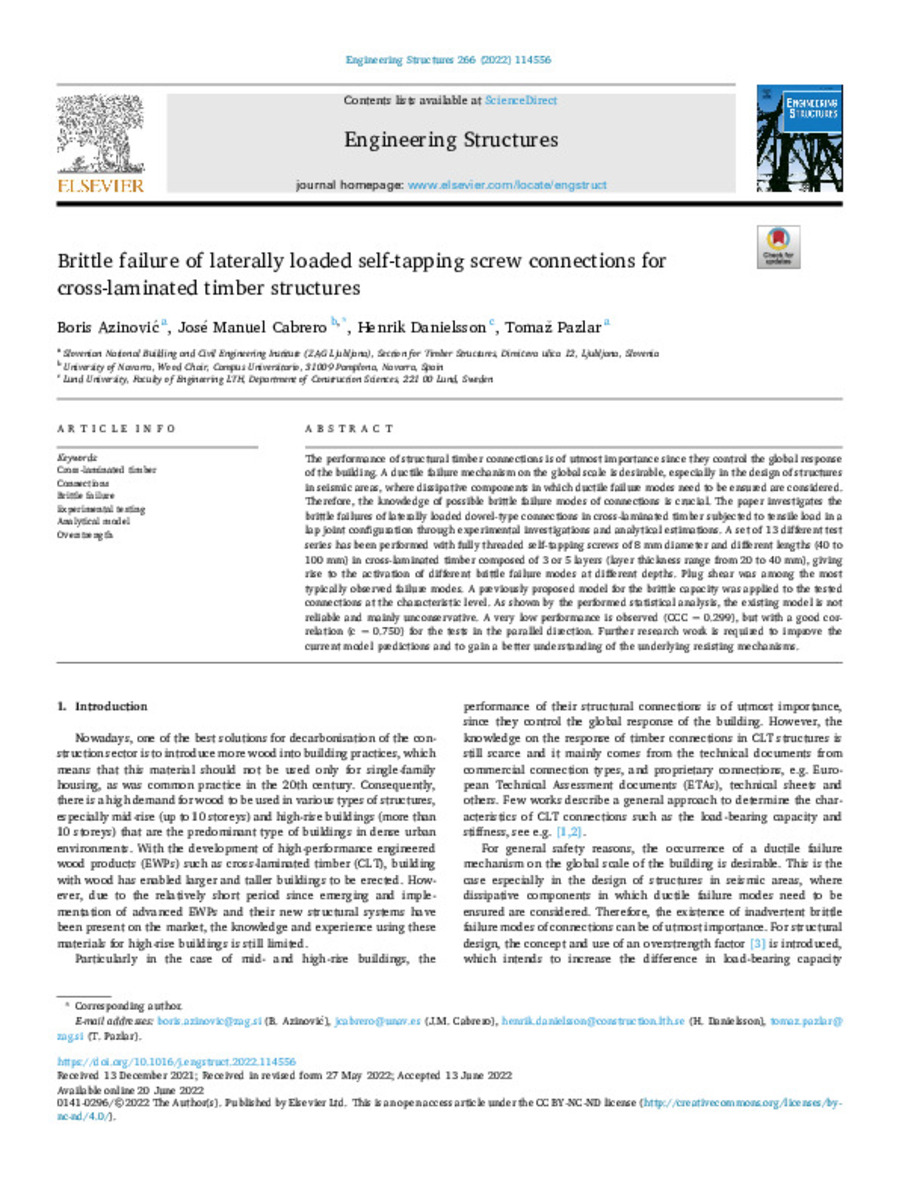Full metadata record
| DC Field | Value | Language |
|---|---|---|
| dc.creator | Azinovic, B. (Boris) | - |
| dc.creator | Cabrero, J.M. (José Manuel) | - |
| dc.creator | Danielsson, H. (Henrik) | - |
| dc.creator | Pazlar, T. (Tomaz) | - |
| dc.date.accessioned | 2022-08-04T08:22:32Z | - |
| dc.date.available | 2022-08-04T08:22:32Z | - |
| dc.date.issued | 2022 | - |
| dc.identifier.citation | Azinovic, B. (Boris); Cabrero, J.M. (José Manuel); Danielsson, H. (Henrik); et al. "Brittle failure of laterally loaded self-tapping screw connections for cross-laminated timber structures". Engineering Structures. (266), 2022, 114556 | es |
| dc.identifier.issn | 0141-0296 | - |
| dc.identifier.uri | https://hdl.handle.net/10171/63862 | - |
| dc.description.abstract | The performance of structural timber connections is of utmost importance since they control the global response of the building. A ductile failure mechanism on the global scale is desirable, especially in the design of structures in seismic areas, where dissipative components in which ductile failure modes need to be ensured are considered. Therefore, the knowledge of possible brittle failure modes of connections is crucial. The paper investigates the brittle failures of laterally loaded dowel-type connections in cross-laminated timber subjected to tensile load in a lap joint configuration through experimental investigations and analytical estimations. A set of 13 different test series has been performed with fully threaded self-tapping screws of 8 mm diameter and different lengths (40 to 100 mm) in cross-laminated timber composed of 3 or 5 layers (layer thickness range from 20 to 40 mm), giving rise to the activation of different brittle failure modes at different depths. Plug shear was among the most typically observed failure modes. A previously proposed model for the brittle capacity was applied to the tested connections at the characteristic level. As shown by the performed statistical analysis, the existing model is not reliable and mainly unconservative. A very low performance is observed (CCC = 0.299), but with a good cor- relation (c = 0.750) for the tests in the parallel direction. Further research work is required to improve the current model predictions and to gain a better understanding of the underlying resisting mechanisms. | es_ES |
| dc.description.sponsorship | The current research has received support within ERA-NET Cofund ForestValue by MIZˇS, VINNOVA, FORMAS, STEM, BMLFUW, FNR and MINECO-AEI and has received funding from the European Union’s Horizon 2020 research and innovation programme under grant agreement N◦ 773324. The financial support provided by Fachagentur Nachwachsende Rohstoffe e.V. (FNR) of the German Federal Ministry of Food and Agriculture (BMEL) and the Spanish Ministerio de Ciencia, Innovación y Universidades – Agencia Estatal de Investigaci ́on under contract PCI2019-103591 AEI is gratefully acknowledged. | es_ES |
| dc.language.iso | eng | es_ES |
| dc.publisher | Elsevier | es_ES |
| dc.rights | info:eu-repo/semantics/openAccess | es_ES |
| dc.subject | Cross-laminated timber | es_ES |
| dc.subject | Connections | es_ES |
| dc.subject | Brittle failure | es_ES |
| dc.subject | Experimental testing | es_ES |
| dc.subject | Analytical model | es_ES |
| dc.subject | Overstrength | es_ES |
| dc.title | Brittle failure of laterally loaded self-tapping screw connections for cross-laminated timber structures | es_ES |
| dc.type | info:eu-repo/semantics/article | es_ES |
| dc.description.note | This is an open access article under the CC BY-NC-ND license | es_ES |
| dc.identifier.doi | 10.1016/j.engstruct.2022.114556 | - |
| dadun.citation.number | 266 | es_ES |
| dadun.citation.publicationName | Engineering Structures | es_ES |
| dadun.citation.startingPage | 114556 | es_ES |
Files in This Item:
Statistics and impact
Items in Dadun are protected by copyright, with all rights reserved, unless otherwise indicated.






